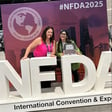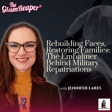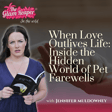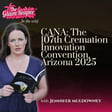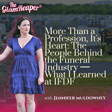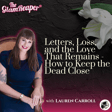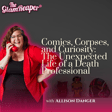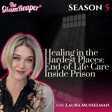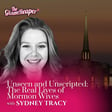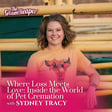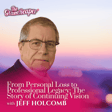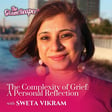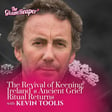
Uncovering New York's Dark History: Death, Mayhem, and Cemeteries
In this captivating episode of The Glam Reaper Podcast, host Jennifer Muldowney, aka The Glam Reaper, takes listeners on a journey through New York City’s darker history with the brilliant K. Krombie, a British author, freelance writer, journalist, and founder of Purefinder New York. All while sitting in Central Park!!
Krombie is renowned for her deeply researched walking tours that shine a light on the city's untold stories of death and cemeteries.
Jennifer and Krombie dive into the fascinating world of burials in the Big Apple, spanning over 400 years of history. Together, they discuss Krombie’s book, Death in New York: History and Culture of Burials, Undertakers and Executions, and explore the mismanagement of death in Manhattan, from overcrowded cemeteries to forgotten burial grounds. They also uncover how epidemics, riots, and even forgotten skeletons have shaped the city’s landscape and reflect on the ongoing challenges of honoring the dead in a space-challenged metropolis.
Whether you’re a history buff or simply curious about New York’s hidden past, this episode will transport you to a side of the city you’ve never seen before. Don’t miss this insightful conversation packed with forgotten tales, burial scandals, and thought-provoking discussions about life and death in the concrete jungle.
Tune in now to learn about the past that’s still buried beneath New York’s streets!
Key Topics:
-History of cemeteries and honoring the deceased
-Epidemics and changes in burial practices
-Cemetery belt and space for loved ones
-Grave robberies and respect for remains
-Krombie’s book and tours on death and legacy
Awesome facts from the episode:
Washington Square Park holds a secret: There are approximately 20,000 bodies buried beneath it, a result of yellow fever epidemics in the 1800s.
Grave robbing was a serious issue in New York: In 1788, a riot broke out when student doctors were caught stealing bodies from cemeteries for dissection, leading to legal reforms.
In the 1700s, drinking water in New York often flowed through graveyards, including a fountain at Trinity Church, contributing to cholera outbreaks.
Seneca Village, located in what is now Central Park, was a black settlement in the 1820s with churches and burial grounds, many of which remain under the park today.
The Bone Bill of 1854 allowed unclaimed bodies, particularly vagrants, to be dissected by medical students, a law that remained in place until it was finally amended in 2016.
Timestamp:
[00:00] Podcast Intro
[00:59] Jennifer and Krombie focused on the fascinating history of cemeteries and death management in New York City.
[05:23] Jennifer and Krombie talk about the extensive cemetery belt in Queens and personal experiences of exploring cemeteries during lockdown.
[08:45] Jennifer and Krombie recounted experiences at a haunted funeral convention in Savannah, Georgia, and explored the history of grave robbing in New York City.
[12:13] Krombie covered a grim historical event where a student doctor in 1788 provoked a riot by claiming a dismembered arm belonged to a boy's recently deceased mother.
[15:01] Jennifer and Krombie reflected on how much there is to learn about death and burial practices.
[18:42] Krombie shared their various tours in New York.
[22:41] Outro
Connect with K.Krombie:
Website - https://www.purefindernewyork.com/
Twitter/X - @KKrombie
Promotional code to get 15% discount: Glamreaper
